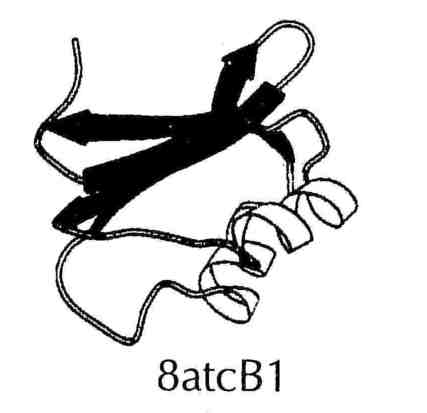


Meeting report
BCA Autumn 93
Industrial Groups
 C. Baxter receives a model of Gamma Prime made from a nickel based superalloy from S. Fletcher, Chairman of the Industrial Group of the BCA. (Photo courtesy of BCA News)
C. Baxter receives a model of Gamma Prime made from a nickel based superalloy from S. Fletcher, Chairman of the Industrial Group of the BCA. (Photo courtesy of BCA News)
The Autumn Meeting of the Industrial Group of the BCA, November 4, 1993, featured a review of the use of X-ray and neutron scattering to elucidate the structure of liquid crystals (R. Richardson, U. Bristol), a comparison of four profile fitting programs (T. Carter, AWE Aldermaston), and an account of the JCPDS-ICDP course held at Manchester, including the successful solution of a difficult multiphase problem using PC-based search software developed by both Siemens and Philips (T. Hyde, Johnson Matthey). A discussion of state-of-the-art pattern simulations and structure visualization by S. Maginn (Molecular Simulations) included examples as wide ranging as quantitative phase analysis, the calculation of zeolite adsorption isotherms, and surface modeling as an aid to the design of habit modifiers.
In other practical talks, J. Shackleton (Philips) showed that instant coffee can be used as a diluent to reduce preferred orientation in samples and B. Cernik demonstrated the power of the energy dispersive station at Daresbury for in situ studies of catalysts and the high-resolution facilities for indexing and structure determination.
Colin Baxter of Rolls-Royce, Derby received one of the two Industrial Group Awards for 1993 for developing routine phase diffraction techniques for aero-engineering, practical diffraction applications in metallurgy, the Single Crystal Orientation Rapid Processing and Interpretation Operation (SCORPIO) System. In his talk entitled "Max von Laue - his part in my downfall," Baxter gave an account of the development of SCORPIO. Over 9% of the Western World's production of single crystal turbine blades are being measured on a SCORPIO system.
Colin Dineen of the GEC Hirst Research Laboratories received the other Industrial Group Award for development of X-ray techniques for the characterization of electronic materials, including semiconductor thin films, contributing to the design of the first Hirst Topographic Camera, and his participation in the diamond identification program using X-ray topography techniques.
Chemical Crystallography
Data collection processing and analysis was the focus of the Autumn Meeting of the Chemical Crystallography Group at Aston University on November 17, 1993. In his opening presentation "A Perspective of Powder Diffraction - Keeping Your Powder Dry", S. Pawley (Edinburgh) raised provocative questions about statistics and their relation to powder diffraction results. What do we really mean by R values, standard deviations, and independent observations? What is the statistical significance of slack constraints in unit cell refinements and the fit of simulated structures to powder diffraction patterns?
H. Flack (Geneva) compared Frequentist and Bayesian Statistics and introduced the term "uncertainty" in contrast to standard deviation, or error. He suggested that single crystal structure refinement should specifically include background refinement, in analogy to Rietveld powder refinement, and he described successful twinning refinement. N. Alcock (Warwick) reviewed empirical and analytical absorption corrections used in recent publications in Acta Cryst. and concluded that they were useful when properly applied, although difabs tended to be empirical fudge factors. He also suggested ways of producing more effective packing pattern illustration.
M. Begley Nottingham) demonstrated that when applying direct methods to data sets with a large proportion of weak data, structures could be more readily phased using statistically scaled E values rather than calculated E's that are typically too low. H. Powell (Cambridge) stressed the merits of collecting redundant data with image plates and the uses that can be made of that data, and J. Cole (Durham) produced evidence that a ratio of 6:1 between data and refined parameters is desirable if not essential.
In his presentation entitled "Can You Believe It?", R. Gould (Edinburgh) gave examples of Ortep plots showing impossible vibrations, difabs correcting for a crystal only half in the beam, measured densities agreeing with miscalculated values, and observed electron density open to numerous interpretations.
S. Fletcher and S. Jutson


